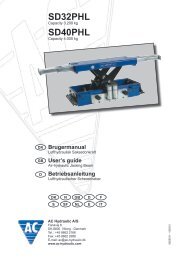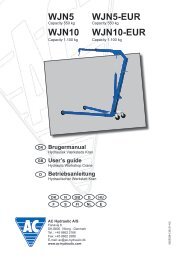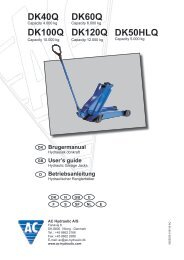WN11 WN20 WN15 WN25 - AC Hydraulic A/S
WN11 WN20 WN15 WN25 - AC Hydraulic A/S
WN11 WN20 WN15 WN25 - AC Hydraulic A/S
Erfolgreiche ePaper selbst erstellen
Machen Sie aus Ihren PDF Publikationen ein blätterbares Flipbook mit unserer einzigartigen Google optimierten e-Paper Software.
GB <strong>WN11</strong>, <strong>WN15</strong><br />
<strong>WN20</strong>, <strong>WN25</strong><br />
WARNING -<br />
Safe usage instructions<br />
1. Study, understand and follow all instructions before<br />
operating this crane.<br />
2. Do not exceed rated capacity.<br />
3. Only use slings and chains with a capacity greater<br />
than the load.<br />
4. Ensure that the load cannot slide or swing during<br />
transport.<br />
5. Legs and extension jib must always be secured<br />
with studs and safety pins.<br />
6. Use only on hard level surface.<br />
7. Lower load to lowest position before transporting.<br />
8. No alterations shall be made to this crane.<br />
9. Failure to follow these warnings may result in per<br />
-sonal injury and/or property damage.<br />
Assembly:<br />
1. Mount fixed wheel (19) with axles and circlips, and<br />
then revolving wheels (21) with screws, washers<br />
and nuts.<br />
2. Raise and mount the mast (3) with screws (22),<br />
washers (12) and two nuts (23).<br />
3. Mount main jib (2) on mast using axle (9) and<br />
circlips (16).<br />
4. Mount the hydraulic unit (6) with axle (5) og circlips<br />
(14).<br />
5. Secure the hydraulic unit with screw (20).<br />
Use:<br />
Lifting: Activate pump handle using full strokes.<br />
Lowering: Slowly turn the release handle counter<br />
clockwise. The spring in the release handle<br />
causes it to close automatically.<br />
The extension jib can be adjusted to different positions<br />
when removing the spike (7). Remember to secure the<br />
jib again with spike and safety pin.<br />
Maintenance:<br />
Maintenance and repair must always be carried out by<br />
qualified personnel.<br />
Daily: Inspect crane for damage.<br />
Monthly: Grease pump piston thrust pad, and oil<br />
handle axle and main jib axle. Also inspect the crane<br />
for unusual wear and tear.<br />
Oil refill: Refill through the filling hole in the cylinder<br />
using an oil can. Correct oil level is up to lower edge<br />
of filling hole (28) with the jib fully down. Too much oil<br />
causes poor pumping.<br />
Quantity of oil <strong>WN11</strong>, <strong>WN15</strong>: 0.8 l.<br />
Quantity of oil <strong>WN20</strong>, <strong>WN25</strong>: 2 l.<br />
Any good hydraulic oil of viscosity ISO VG 15 can be used.<br />
NEVER USE BRAKE FLUID!<br />
Safety Inspection:<br />
In accordance with national legislation – minimum<br />
once a year though – the crane must be inspected by<br />
a professional: damages, wear and tear, safety catch<br />
on the hook, adjustment of the safety valve, hydraulic<br />
unit for leakages. Furthermore that all safety labels are<br />
legible.<br />
Trouble shooting:<br />
1. The crane does not lift to maximum position but the<br />
pump retains pressure: refill with oil.<br />
2. Poor pumping (half strokes): vacuum in the reser<br />
voir. Loosen the filling plug (28) and verify oil level.<br />
3. The load is dropping: verify release handle is<br />
closed and release spring (dead man’s control) is<br />
properly adjusted. Pre-tension of spring (40/38) is<br />
max. half a turn. If this is not the cause, then the<br />
pump needs repair (worn seals or valves).<br />
Spare parts:<br />
Replace worn or broken parts with original spare parts<br />
only. All major parts may not be available after discontinuation<br />
of a model.<br />
Destruction:<br />
Oil must be drained off and legally disposed of.








